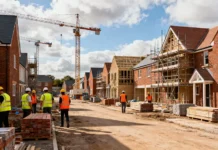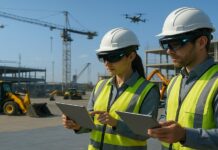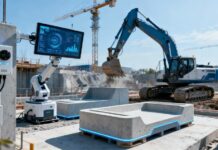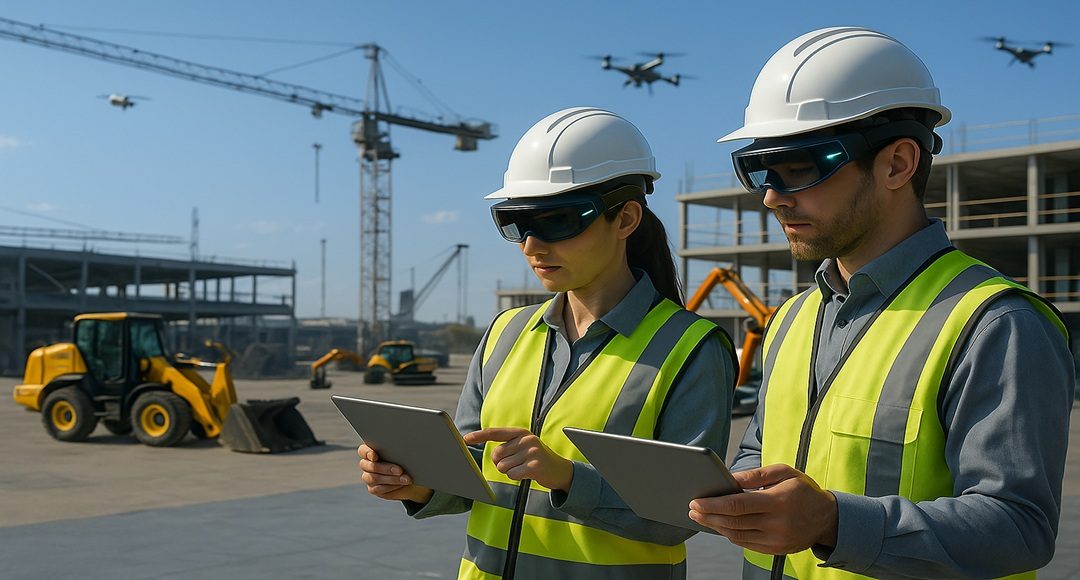The construction industry has long been recognized as a cornerstone of global economic development. With the pace of urbanization and technological innovation accelerating, changing the ways conventional processes are carried out, the construction tech market is poised for unprecedented expansion. Over the next decade, innovations such as Building Information Modeling (BIM), drones, robotics, prefabrication, and AI-supported project management will redefine how work is done, safety regulations, and overall sustainability plan. This systemic view will examine the current market situation, forecasted trends, and implications for the construction technology market for 2025 and 2035 – ultimately providing the industry stakeholders meaningful contextualization of the emerging trends and future opportunities.
Market Overview and Growth Trajectory
The construction tech industry has grown exponentially since the last few years, spurred on mostly by the growing demand for efficiency, cost savings, and sustainability. According to the most recent industry reports, the international construction technology market was worth around USD 7,000 million in 2025, with a compound annual growth rate (CAGR) of 16.9% during the period 2025-2035. This growth is underpinned by extensive use of digital solutions, automation, and novel construction techniques minimising project duration and risk exposure.
Forecasts suggest that by 2035 the market will surpass USD 30,000 million, evidencing the importance of the industry to fostering resilient and sustainable urban development. Factors contributing to this include increasing adoption of IoT-enabled building machinery, the rise of smart building, and government incentives for green infrastructure. In addition, the digital revolution is increasingly being brought into core construction practices, setting the stage for smarter, safer, and sustainable project delivery.
Growth Drivers and Industry Catalysts
At the center of this growth story is it’s innovation in the technology. Technology, especially through the use of BIM, allows for detailed 3D modeling of building projects, has improved project coordination, clash detection, and overall lifecycle management. AI and machine learning are employed for predictive maintenance, developing safety measures, and simplifying supply chains. Furthermore, robotics and autonomous equipment are minimizing labor shortages and maximizing precision.
Regulatory guidelines and government programs to reduce carbon emissions are also significant. Germany, China, and the United States, for example, are investing in green building codes, encouraging the use of energy-efficient systems, and promoting sustainable materials. For example, the initiatives of the U.S. Green Building Council have led to a proliferation of smart, energy-efficient window and door systems that represent approximately half of the construction technology market. Emerging technologies are also driving acceptance of modular construction, where prefabricated sections made off-site are rapidly assembled on-site. This eliminates waste, decreases the time required to complete construction, and reduces the impact of construction activity in densely populated metropolitan centers, which is part of the rising demand for innovative technology solutions for construction.
Regional Market Dynamics
The North American market is leading the charge in the adoption of construction technologies as a result of large-scale infrastructure investments, a mature construction sector and progressive regulation. Europe with several large nations including Germany, the UK, and France, investing heavily in digital infrastructure and green construction. The Asia-Pacific area is likely to see the largest growth based on very rapid urbanization, industrialization, and policies supporting these developments in China, India, and the Southeast Asia region.
Segmental Analysis and Market Drivers
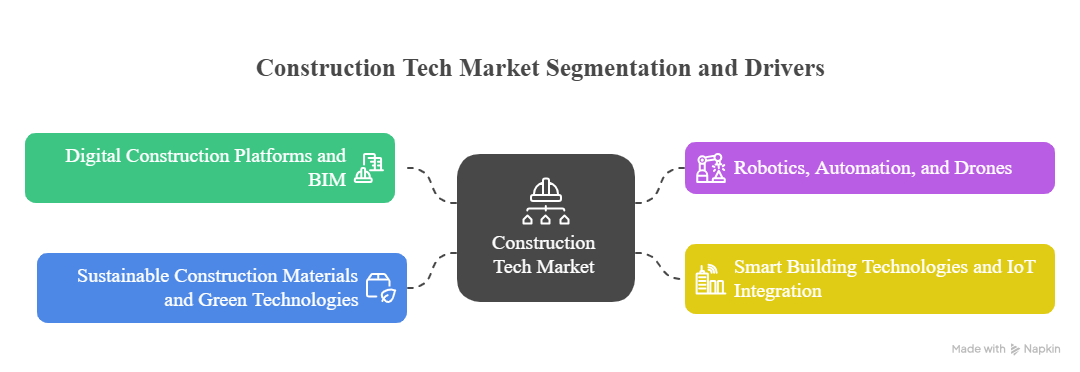
The construction tech market is highly segmented due to the various applications the technology can use including residential, commercial, and infrastructure projects. The growth of each segment is determined by particular technological trends and local policies, which are defining the overall industry picture.
-
Digital Construction Platforms and Building Information Modeling
Underlying the development of construction tech is BIM, now a norm in project planning and delivery. The growth of BIM adoption occurred due to an increasing number of regulatory laws that will make the use of BIM compulsory for large projects. The technology’s ability to provide rich, detailed digital models of a real property lends itself to ease in sharing amongst contractors, engineers, and architects. The digitization drastically minimizes mistakes, reworking, and delay in projects, resulting in considerable cost reductions and increases in efficiency.
-
Robotics, Automation, and Drones
Robotics and automation are changing how we perform labor-intensive tasks, especially in concrete placement, bricklaying and site assessments; while drones are becoming the preferred tool for site surveys, maintaining progress monitoring, and safety inspections in hard-to-access or unsafe areas.
Autonomous equipment outfitted with GPS and sensors allows for precise earth moving, material handling, and management of site logistics. Updating technologies are transitioning away from labor reliance into machinery and obtaining more education and efficiencies for safety on sites.
-
Smart Building Technologies and IoT Integration
Smart building technologies, including IoT sensors, automation, and energy management systems, are transforming the construction of the future. These technologies allow for utilities, structural health, and energy usage to be monitored in real-time, thus maximizing the performance of buildings far after the construction process is completed.
Utilizing networked sensors in windows, doors, HVAC, lighting systems not only improves occupants’ comfort, but can also significantly maximize energy savings.
-
Sustainable Construction Materials and Green Technologies
Sustainability is still a concern in construction tech development. The ongoing trend towards green materials, energy-efficient windows and doors, and integrating renewable energy, is changing product design and market demand at present. New materials like ultra-insulating glass, recycled content composites, and low-impact manufacturing processes are becoming more popular.
Expansion in this category comes in line with world attempts to minimize the carbon footprint of buildings. According to recent industry projections, green building materials are fueled by more stringent environment regulations and increasing consumer awareness.
Market Trends and Future Outlook
The construction tech market is set to experience a future unlike any other through the unprecedented intersection of digital and physical worlds. The emerging depth in the incorporation of artificial intelligence, big data analytics, and edge computing throughout construction processes, will continue to provide improved predictive capabilities, improved supply chain efficiency, and improved safety systems.
Now include 5G connectivity which will facilitate the transport of data in real-time and remote operations of equipment. This represents the beginning of a new era in smart and connected construction sites. Autonomous and electric equipment will be commonplace and will not only be available, as local governments and cities demand emissions reductions and more sustainable urbanisation.
The integration of digital twins, or virtual representations of a physical asset, will empower lifecycle management from planning, design, construction, and through to decommissioning. Digital twins will allow developers and operators to model performance, predict failures, and optimize maintenance by avoiding repairs, improving their timing and prolonging the remaining useful life of infrastructure assets.
Conclusion
The technology market for construction is set to grow exponentially over the next decade. Driven by technological innovations, the urgent need for sustainable ways of growth, and changing regulatory contexts, the construction industry will revive itself with the integration of robotics and digital platforms, green materials, and the IoT, resulting in a sector that is collectively more resilient, efficient, and sustainable.
The market is expected to be as much as 30,000 million by 2035, headed by North America, Europe, and Asia-Pacific. As the construction companies embrace holistic, data-driven solutions, not only will they improve project delivery, but they will also be helping to address climate change on a worldwide level and urban sustainability.
In this fast-evolving world, the industry leaders need to keep evolving, invest in new technologies, and collaborate across sectors to realize the full potential of construction technology. The future is full of great promise—building smarter, safer, and more sustainable cities for the next generation.

















